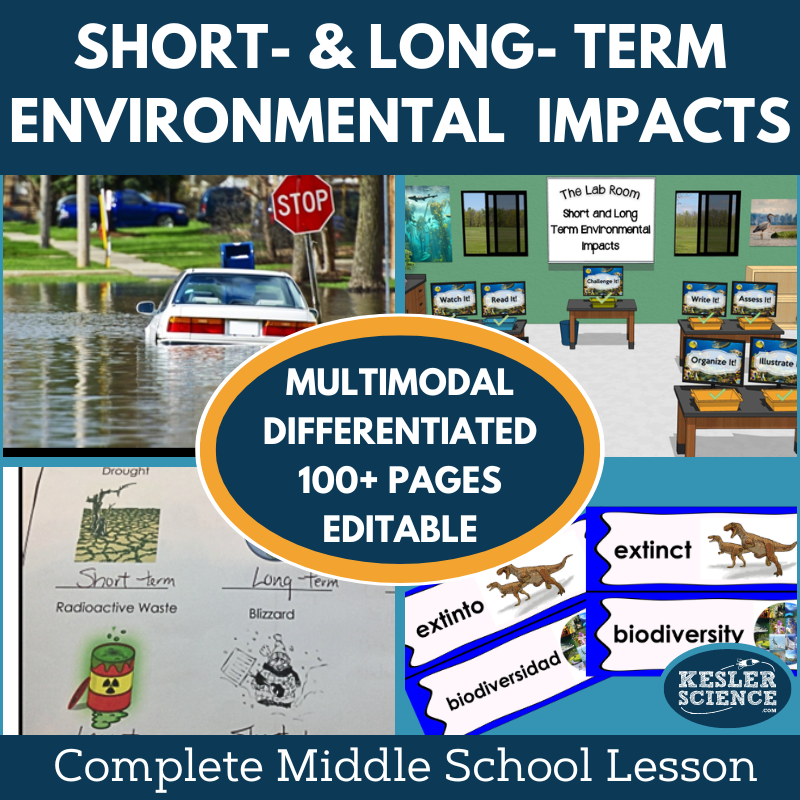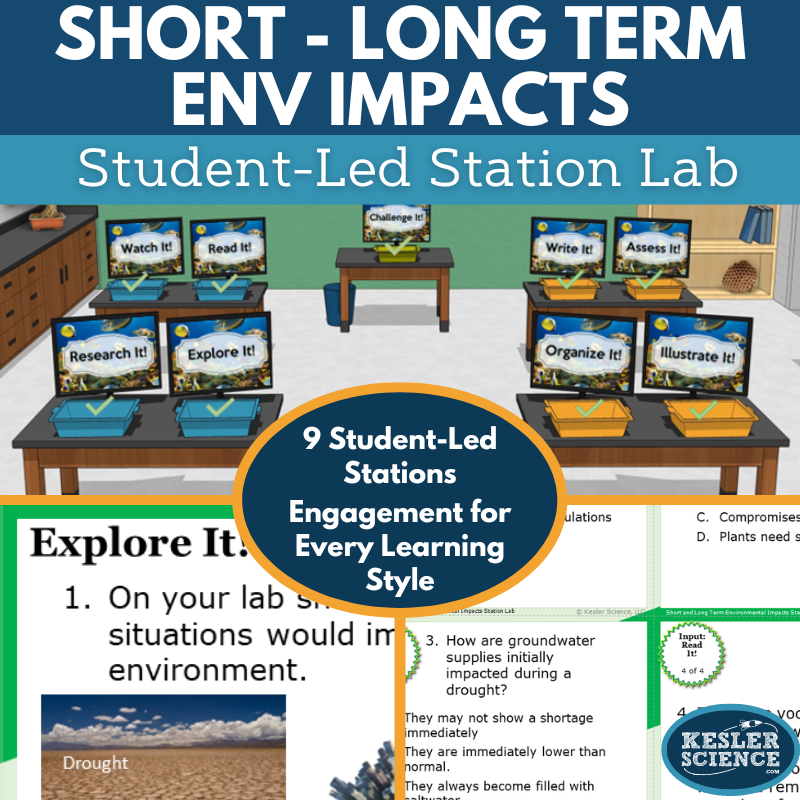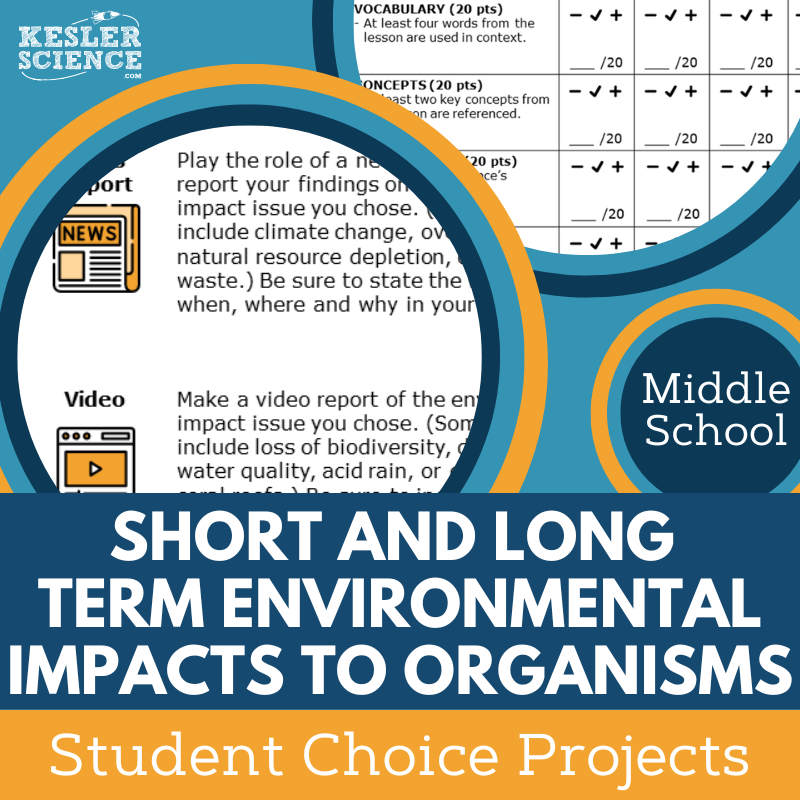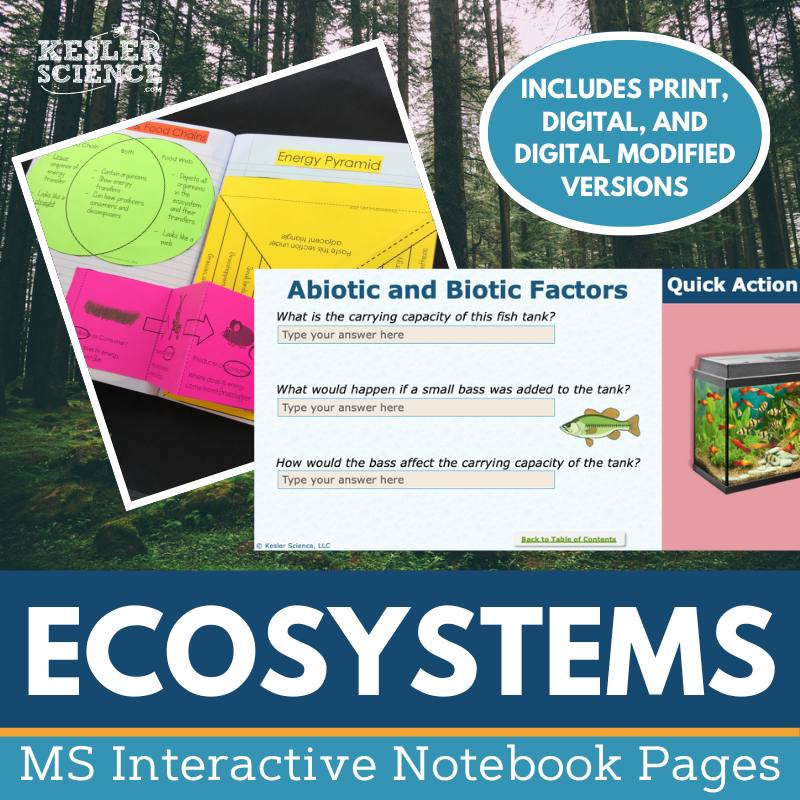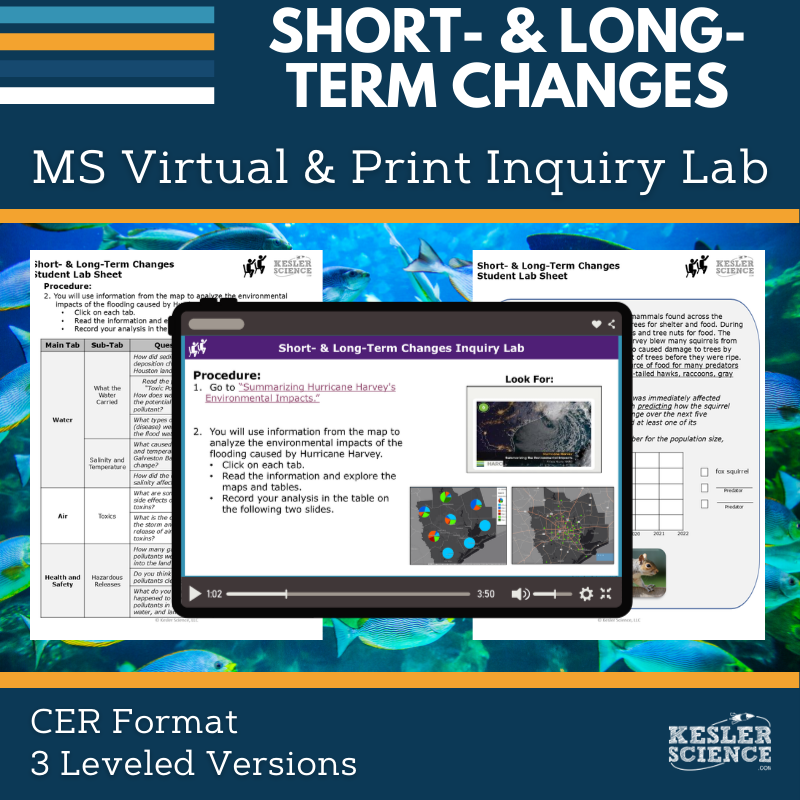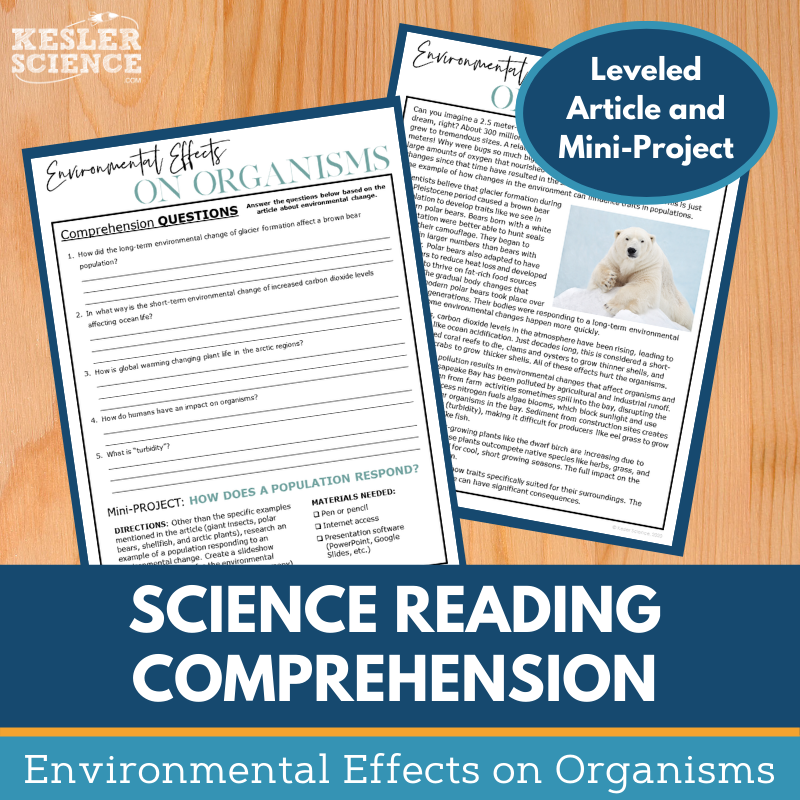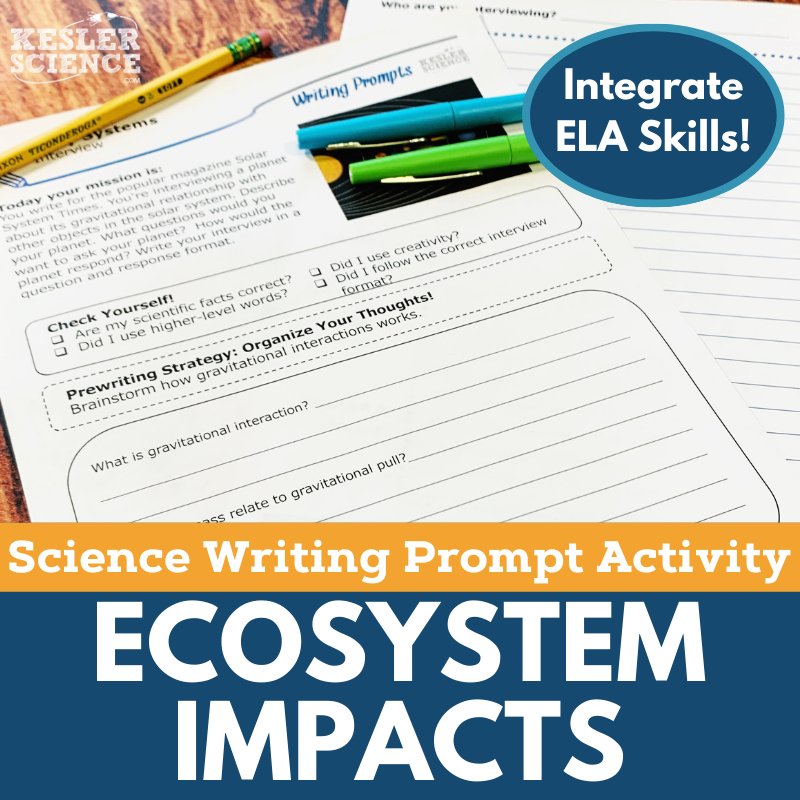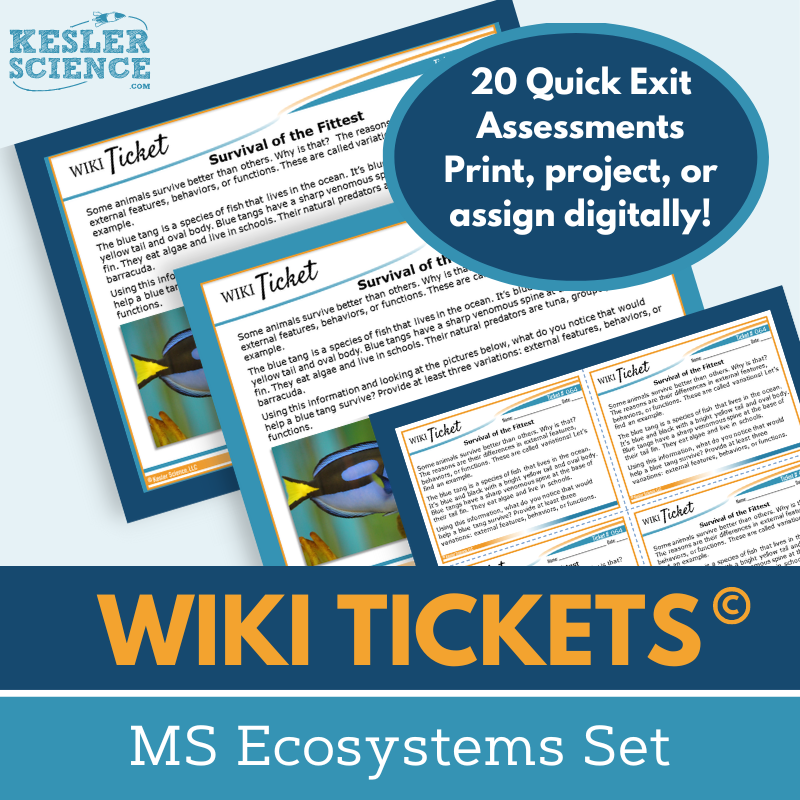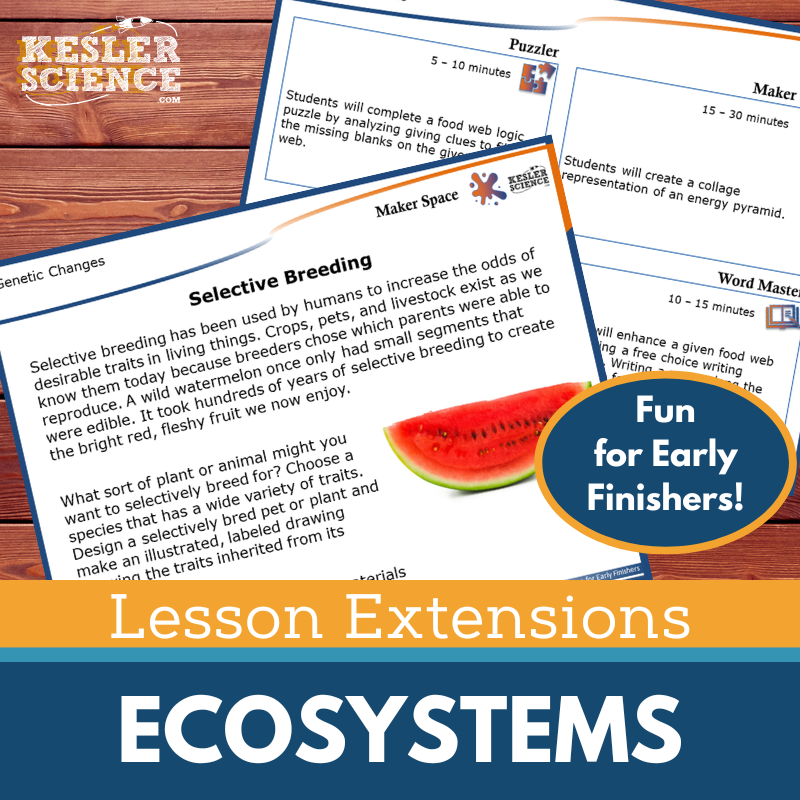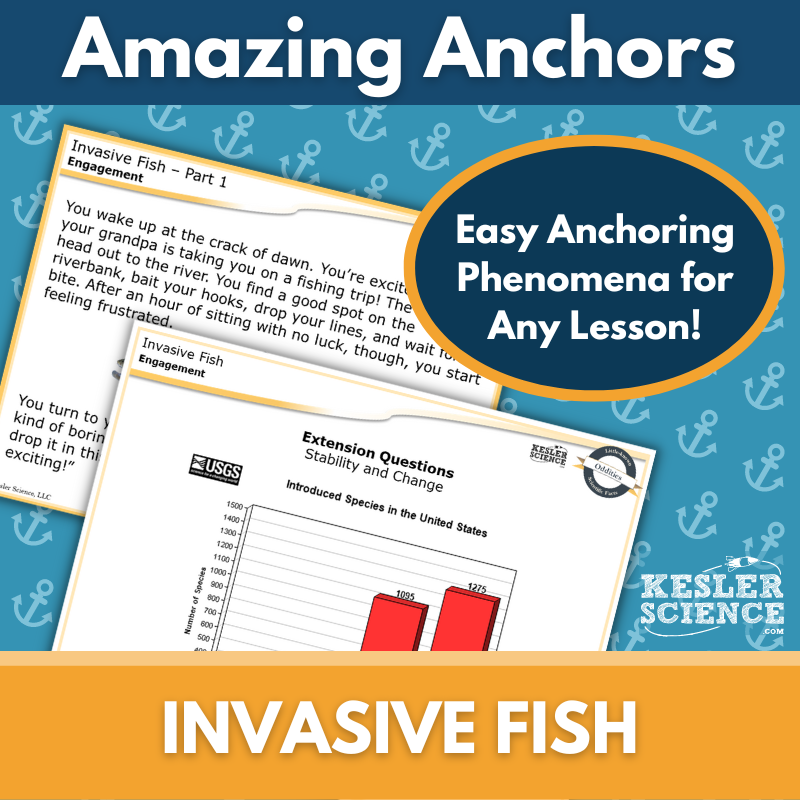Short- and Long-Term Environmental Impacts Activities for Middle School Science
The Kesler Science Short- and Long-Term Environmental Impacts resources offer a complete, student-centered learning experience for middle school science classrooms. The resources below will give students a comprehensive understanding of short- and long-term environmental impacts. All of the following materials are also included in the Kesler Science Membership.
The Kesler Science Short- and Long-Term Environmental Impacts Complete 5E Lesson offers a ready-to-use, engaging multi-day lesson for 6th-8th grade students. It includes all the materials you need to teach a comprehensive unit on how environmental changes affect organisms and their traits. With minimal prep, differentiated resources, and a student-led approach, teachers can focus on student success while students lead their own learning.
The lesson is designed around the 5E Model: Engagement, Exploration, Explanation, Elaboration, and Evaluation. Students begin with engaging activities such as word wall cards and discussions, then explore short- and long-term environmental impacts through nine differentiated stations. These include hands-on activities like experiments, reading passages, research, and videos that allow students to absorb and demonstrate their understanding in a variety of ways.
Additionally, the lesson includes editable PowerPoints, interactive notebook templates, and student-choice projects for deeper learning. The resource is flexible for both in-person and virtual classrooms, offering digital and print versions of materials in English and Spanish. Assessments are aligned with standards, and the lesson includes bonus activities for early finishers to extend learning further.
The Kesler Science Short- and Long-Term Environmental Impacts Complete 5E Lesson offers a ready-to-use, engaging multi-day lesson for 6th-8th grade students. It includes all the materials you need to teach a comprehensive unit on how environmental changes affect organisms and their traits. With minimal prep, differentiated resources, and a student-led approach, teachers can focus on student success while students lead their own learning.
The lesson is designed around the 5E Model: Engagement, Exploration, Explanation, Elaboration, and Evaluation. Students begin with engaging activities such as word wall cards and discussions, then explore short- and long-term environmental impacts through nine differentiated stations. These include hands-on activities like experiments, reading passages, research, and videos that allow students to absorb and demonstrate their understanding in a variety of ways.
Additionally, the lesson includes editable PowerPoints, interactive notebook templates, and student-choice projects for deeper learning. The resource is flexible for both in-person and virtual classrooms, offering digital and print versions of materials in English and Spanish. Assessments are aligned with standards, and the lesson includes bonus activities for early finishers to extend learning further.
The Kesler Science Short- and Long-Term Environmental Impacts Station Lab offers a student-led, modular learning experience that engages middle school students in studying the environmental effects of natural events. The nine differentiated stations, including a challenge station for early finishers, allow students to explore concepts independently or in small groups, while teachers facilitate learning. The materials are designed to save prep time, making it easy for educators to implement.
The stations are divided into input and output activities. Input stations, such as "Explore It!" and "Watch It!", provide hands-on demonstrations, research tasks, reading passages, and videos to introduce and reinforce environmental impact concepts. Output stations like "Organize It!" and "Illustrate It!" allow students to apply what they've learned through creative tasks, including drawing, writing, and organizing information.
This resource is adaptable for in-person or virtual learning, with all required materials provided for each station. Students can use digital tools like PowerPoint or Google Slides for activities, while manipulatives are used for hands-on experiences in the classroom. This modular station lab provides a flexible and interactive way for students to study and demonstrate their understanding of short- and long-term environmental impacts.
The Kesler Science Short- and Long-Term Environmental Impacts Station Lab offers a student-led, modular learning experience that engages middle school students in studying the environmental effects of natural events. The nine differentiated stations, including a challenge station for early finishers, allow students to explore concepts independently or in small groups, while teachers facilitate learning. The materials are designed to save prep time, making it easy for educators to implement.
The stations are divided into input and output activities. Input stations, such as "Explore It!" and "Watch It!", provide hands-on demonstrations, research tasks, reading passages, and videos to introduce and reinforce environmental impact concepts. Output stations like "Organize It!" and "Illustrate It!" allow students to apply what they've learned through creative tasks, including drawing, writing, and organizing information.
This resource is adaptable for in-person or virtual learning, with all required materials provided for each station. Students can use digital tools like PowerPoint or Google Slides for activities, while manipulatives are used for hands-on experiences in the classroom. This modular station lab provides a flexible and interactive way for students to study and demonstrate their understanding of short- and long-term environmental impacts.
The Kesler Science Short- and Long-Term Environmental Impacts Student Choice Projects allow middle school students to select from multiple project options based on their preferred learning style. With six different student-led project choices and the option to "design your own," this flexible resource caters to various student interests and encourages creative expression. A customizable grading rubric supports assessments by teachers, peers, or students themselves.
This resource includes nine project options, a teacher directions page for guidance, and editable rubric pages. The projects are designed to assess vocabulary, concepts, presentation, and clarity, offering a dynamic way for students to demonstrate their knowledge. Additionally, there are differentiated versions to support students with varying levels of need, allowing for personalized learning experiences.
Teachers can easily modify the rubric for different grading needs and select projects that align with their students' strengths. Many of the projects can be completed with basic classroom supplies such as paper, markers, and scissors, and several projects can also be done digitally. This resource ensures that students have multiple opportunities to showcase their learning in engaging, hands-on ways.
The Kesler Science Short- and Long-Term Environmental Impacts Student Choice Projects allow middle school students to select from multiple project options based on their preferred learning style. With six different student-led project choices and the option to "design your own," this flexible resource caters to various student interests and encourages creative expression. A customizable grading rubric supports assessments by teachers, peers, or students themselves.
This resource includes nine project options, a teacher directions page for guidance, and editable rubric pages. The projects are designed to assess vocabulary, concepts, presentation, and clarity, offering a dynamic way for students to demonstrate their knowledge. Additionally, there are differentiated versions to support students with varying levels of need, allowing for personalized learning experiences.
Teachers can easily modify the rubric for different grading needs and select projects that align with their students' strengths. Many of the projects can be completed with basic classroom supplies such as paper, markers, and scissors, and several projects can also be done digitally. This resource ensures that students have multiple opportunities to showcase their learning in engaging, hands-on ways.
The Kesler Science Ecosystems Interactive Notebook Bundle provides an engaging and interactive way for students to explore key ecosystems concepts. Designed for flexibility, the resource includes both print and digital versions, making it suitable for traditional classrooms, 1:1 environments, and distance learning settings.
The bundle covers a wide range of topics, including biotic and abiotic factors, biomes, food webs, symbiosis, and the nitrogen and carbon cycles. Digital features include a unique interactive notebook PowerPoint, editable Google Slides compatibility, reflection pages, and modified versions for students with accommodations. The paper version includes blank and pre-filled templates, complete with color examples to guide students and teachers.
This resource supports differentiated instruction and accommodates all learners with thoughtfully designed templates and modifications. Whether in person or online, the Ecosystems Interactive Notebook promotes active learning, critical thinking, and scientific literacy.
The Kesler Science Ecosystems Interactive Notebook Bundle provides an engaging and interactive way for students to explore key ecosystems concepts. Designed for flexibility, the resource includes both print and digital versions, making it suitable for traditional classrooms, 1:1 environments, and distance learning settings.
The bundle covers a wide range of topics, including biotic and abiotic factors, biomes, food webs, symbiosis, and the nitrogen and carbon cycles. Digital features include a unique interactive notebook PowerPoint, editable Google Slides compatibility, reflection pages, and modified versions for students with accommodations. The paper version includes blank and pre-filled templates, complete with color examples to guide students and teachers.
This resource supports differentiated instruction and accommodates all learners with thoughtfully designed templates and modifications. Whether in person or online, the Ecosystems Interactive Notebook promotes active learning, critical thinking, and scientific literacy.
The Kesler Science Short- and Long-Term Changes Inquiry Lab aligns with NGSS standards by guiding students through an investigation of the short- and long-term environmental effects of flooding during Hurricane Harvey. Students will also make predictions about how populations might respond to these environmental changes. The lab can be completed as a hands-on printed activity or a fully interactive digital version, both including comprehension questions, Claim-Evidence-Reasoning (C.E.R.) prompts, and a reflection section.
This resource offers built-in differentiation with three levels: a structured version for students who need support, a guided version for on-level learners, and a more open-ended version for advanced students. The digital version features a recorded video of the entire procedure, allowing students to follow along as they attempt to remove oil, glitter, and plastic from water, simulating real environmental cleanup. Students without materials or who are learning remotely can still engage with virtual simulations embedded directly into the file.
All materials are editable and compatible with Google Slides, providing maximum flexibility. Teachers receive answer keys, detailed directions, and support materials to simplify preparation. With its multimodal learning approach, this lab keeps middle school students engaged while supporting science practices, crosscutting concepts, and core ideas in environmental science.
The Kesler Science Short- and Long-Term Changes Inquiry Lab aligns with NGSS standards by guiding students through an investigation of the short- and long-term environmental effects of flooding during Hurricane Harvey. Students will also make predictions about how populations might respond to these environmental changes. The lab can be completed as a hands-on printed activity or a fully interactive digital version, both including comprehension questions, Claim-Evidence-Reasoning (C.E.R.) prompts, and a reflection section.
This resource offers built-in differentiation with three levels: a structured version for students who need support, a guided version for on-level learners, and a more open-ended version for advanced students. The digital version features a recorded video of the entire procedure, allowing students to follow along as they attempt to remove oil, glitter, and plastic from water, simulating real environmental cleanup. Students without materials or who are learning remotely can still engage with virtual simulations embedded directly into the file.
All materials are editable and compatible with Google Slides, providing maximum flexibility. Teachers receive answer keys, detailed directions, and support materials to simplify preparation. With its multimodal learning approach, this lab keeps middle school students engaged while supporting science practices, crosscutting concepts, and core ideas in environmental science.
In this engaging middle school science lesson, students explore how short- and long-term environmental changes impact organisms and traits in future populations. After reading a nonfiction article on the topic, students answer comprehension questions and create a slideshow that highlights how a specific population has responded to environmental change.
Designed to build both science literacy and reading comprehension, the resource includes two leveled articles (Lexile 1100–1300), 5–7 comprehension questions, and a hands-on mini-project. A Cornell notes template is provided to support student organization. The passage is appropriate for grades 6–8 and features colorful graphics that also print clearly in grayscale.
The lesson can be used in a variety of settings, including virtual learning platforms like Google Classroom, MS Teams, Schoology, and Canvas. The editable slides allow students to complete the activity digitally or in person. Ideal for sub plans, enrichment, or whole-class instruction, the reading activity promotes critical thinking, discussion, and student engagement.
In this engaging middle school science lesson, students explore how short- and long-term environmental changes impact organisms and traits in future populations. After reading a nonfiction article on the topic, students answer comprehension questions and create a slideshow that highlights how a specific population has responded to environmental change.
Designed to build both science literacy and reading comprehension, the resource includes two leveled articles (Lexile 1100–1300), 5–7 comprehension questions, and a hands-on mini-project. A Cornell notes template is provided to support student organization. The passage is appropriate for grades 6–8 and features colorful graphics that also print clearly in grayscale.
The lesson can be used in a variety of settings, including virtual learning platforms like Google Classroom, MS Teams, Schoology, and Canvas. The editable slides allow students to complete the activity digitally or in person. Ideal for sub plans, enrichment, or whole-class instruction, the reading activity promotes critical thinking, discussion, and student engagement.
The Ecosystem Impacts Science Writing Activity invites middle school students to deepen their understanding of life science concepts through a creative, call-to-action writing prompt. Designed for both print and digital use, the activity encourages students to strengthen their science reasoning while crafting persuasive writing. It’s ideal for in-class or virtual learning environments, offering flexibility and engagement across learning settings.
This TEKS- and NGSS-aligned resource includes teacher directions, answer guides, rubrics, and both full- and half-sheet student handouts. The digital version, available in PowerPoint and Google Slides, allows students to complete the assignment in Edit mode. A pre-writing strategy and self-check tools help guide students through the process, while interactive notebook-sized versions are perfect for ongoing writing journals.
Teachers can use this versatile activity in a variety of ways, including as a cross-curricular assignment, pre-test assessment, enrichment project, extra credit opportunity, or TELPAS writing sample. Whether displayed on a bulletin board or compiled into a class anthology, this writing prompt promotes creativity, science literacy, and student ownership of learning.
The Ecosystem Impacts Science Writing Activity invites middle school students to deepen their understanding of life science concepts through a creative, call-to-action writing prompt. Designed for both print and digital use, the activity encourages students to strengthen their science reasoning while crafting persuasive writing. It’s ideal for in-class or virtual learning environments, offering flexibility and engagement across learning settings.
This TEKS- and NGSS-aligned resource includes teacher directions, answer guides, rubrics, and both full- and half-sheet student handouts. The digital version, available in PowerPoint and Google Slides, allows students to complete the assignment in Edit mode. A pre-writing strategy and self-check tools help guide students through the process, while interactive notebook-sized versions are perfect for ongoing writing journals.
Teachers can use this versatile activity in a variety of ways, including as a cross-curricular assignment, pre-test assessment, enrichment project, extra credit opportunity, or TELPAS writing sample. Whether displayed on a bulletin board or compiled into a class anthology, this writing prompt promotes creativity, science literacy, and student ownership of learning.
The Kesler Science Ecosystems WIKI Tickets are versatile formative assessments designed for 6th-8th grade science topics. These engaging assessments come in five formats for each topic: full screen for projection, three handout sizes (full, split, and quarter-page), and a digital interactive version that can be used as an editable PPT or Google Slides file. Perfect for checking understanding, these WIKI Tickets provide flexible options for in-person and virtual learning environments.
Aligned with NGSS and TEKS standards, each WIKI Tickets set includes a variety of topics like biodiversity, ecosystems, photosynthesis, and human impact. A bonus table of contents helps teachers quickly find the alignment for each standard. Some topics even have multiple tickets to reinforce key concepts and support student learning.
These assessments are ideal for use as exit tickets, bellringers, or anytime you need quick feedback on student progress. With digital and print formats available, they can be easily adapted for any classroom setting, providing a fun and effective way to gauge students' understanding of science concepts.
The Kesler Science Ecosystems WIKI Tickets are versatile formative assessments designed for 6th-8th grade science topics. These engaging assessments come in five formats for each topic: full screen for projection, three handout sizes (full, split, and quarter-page), and a digital interactive version that can be used as an editable PPT or Google Slides file. Perfect for checking understanding, these WIKI Tickets provide flexible options for in-person and virtual learning environments.
Aligned with NGSS and TEKS standards, each WIKI Tickets set includes a variety of topics like biodiversity, ecosystems, photosynthesis, and human impact. A bonus table of contents helps teachers quickly find the alignment for each standard. Some topics even have multiple tickets to reinforce key concepts and support student learning.
These assessments are ideal for use as exit tickets, bellringers, or anytime you need quick feedback on student progress. With digital and print formats available, they can be easily adapted for any classroom setting, providing a fun and effective way to gauge students' understanding of science concepts.
The Kesler Science Ecosystems Lesson Extensions offer student-choice activities to challenge fast finishers and encourage critical thinking. These activities provide engaging ways to deepen learning and can be used to wrap up lessons, prevent distractions, or fill gaps during testing. Each extension is designed to scaffold learning with activities that align with NGSS and TEKS standards, making them perfect for students ready to explore topics like ecosystems in more depth.
Included in each Lesson Extension are four activity types: Puzzler, Maker Space, Tech Connection, and Word Master. These activities focus on problem-solving, STEAM connections, digital media, and creative writing, providing opportunities for students to apply their knowledge in diverse and engaging ways. Both digital and paper versions are available, with teacher directions and answer keys for easy implementation.
These extensions are ideal for pushing independent learners further, offering rigorous, fun, and hands-on learning opportunities. With topics ranging from biodiversity to ecosystems and environmental changes, these resources help extend students' understanding of science concepts while reinforcing critical skills.
The Kesler Science Ecosystems Lesson Extensions offer student-choice activities to challenge fast finishers and encourage critical thinking. These activities provide engaging ways to deepen learning and can be used to wrap up lessons, prevent distractions, or fill gaps during testing. Each extension is designed to scaffold learning with activities that align with NGSS and TEKS standards, making them perfect for students ready to explore topics like ecosystems in more depth.
Included in each Lesson Extension are four activity types: Puzzler, Maker Space, Tech Connection, and Word Master. These activities focus on problem-solving, STEAM connections, digital media, and creative writing, providing opportunities for students to apply their knowledge in diverse and engaging ways. Both digital and paper versions are available, with teacher directions and answer keys for easy implementation.
These extensions are ideal for pushing independent learners further, offering rigorous, fun, and hands-on learning opportunities. With topics ranging from biodiversity to ecosystems and environmental changes, these resources help extend students' understanding of science concepts while reinforcing critical skills.
This Amazing Anchors Phenomenon Lesson introduces and reinforces the concept of invasive species through a real-world connection to a fishing trip. Students begin with an engaging introductory reading and follow-up questions to activate prior knowledge and build curiosity. A second explanatory reading provides a clear scientific breakdown of invasive species, accompanied by comprehension and extension questions to deepen understanding.
The resource includes teacher directions with answer keys, full-page projection slides, and both print and digital versions of the student handouts. Materials are editable and aligned with NGSS MS LS2-4 and corresponding TEKS standards. A differentiated version supports students who need additional help, offering modified language and sentence starters for accessibility.
Designed to supplement your core lesson, these bookend readings are ideal for the Engage and Elaborate phases of a 5E lesson plan. Whether used in person or virtually, this no-prep, standards-aligned resource helps students explore ecological impacts in an engaging and meaningful way.
This Amazing Anchors Phenomenon Lesson introduces and reinforces the concept of invasive species through a real-world connection to a fishing trip. Students begin with an engaging introductory reading and follow-up questions to activate prior knowledge and build curiosity. A second explanatory reading provides a clear scientific breakdown of invasive species, accompanied by comprehension and extension questions to deepen understanding.
The resource includes teacher directions with answer keys, full-page projection slides, and both print and digital versions of the student handouts. Materials are editable and aligned with NGSS MS LS2-4 and corresponding TEKS standards. A differentiated version supports students who need additional help, offering modified language and sentence starters for accessibility.
Designed to supplement your core lesson, these bookend readings are ideal for the Engage and Elaborate phases of a 5E lesson plan. Whether used in person or virtually, this no-prep, standards-aligned resource helps students explore ecological impacts in an engaging and meaningful way.
Year-Round Resources
These year-round activities will increase your students' understanding of many middle school science topics. All of these activities are also included in the Kesler Science Membership.
Visual Data & Graphing
You're not alone if your students struggle with understanding graphs, charts, and tables. It's a skill that takes an enormous amount of practice. This resource will help students build a strong foundation in analyzing data and creating their own data visualizations.
Bell Ringers and Warm-Ups
These middle school science bell ringers are an excellent way to engage your students as soon as they walk into your classroom. This comprehensive FULL YEAR resource includes everything you need to start off each science class with an interesting warm-up activity.
Review Board Games
Each game board has been carefully designed to keep students engaged. There are 10 different action spaces on each board and dozens of question cards. All of the actions are related to science concepts and keep the students motivated throughout the game.
Each game is ready to play. Simply print out the board and the cards and let the students enjoy reviewing nine different units.
Essential Questions
Below are the essential questions associated with the lessons and activities included in this unit. This topic is only one of more than 100 middle school science topics included in the Kesler Science Membership.
-
How do environmental changes (both short- and long-term) affect organisms and traits in subsequent populations?
Kesler Science Membership
Imagine never having to search for another middle school science lesson again. The membership gives you access to ALL of the Kesler Science products in one place (Yes, including everything above).
Say goodbye to long hours of lesson prep.

